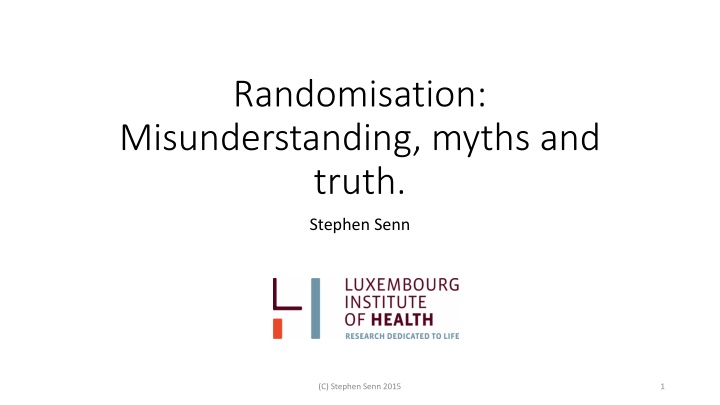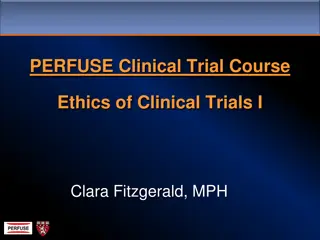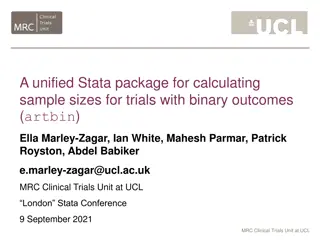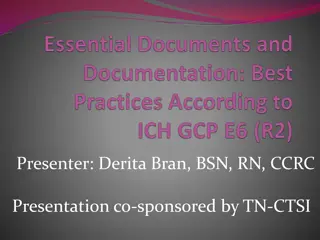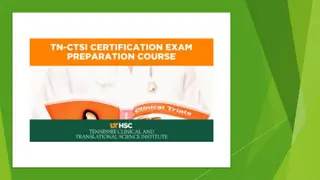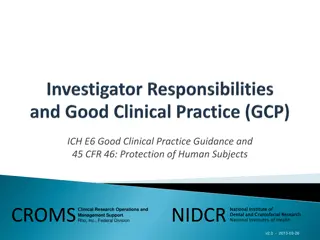Randomisation in Clinical Trials: Practical Background and Theory
Randomisation in clinical trials plays a crucial role in ensuring unbiased results. This article explores the basics, principles, and practical examples of randomisation, emphasizing the importance of understanding both the theory and real-world application. From comparing new treatments to controls to patient recruitment processes, randomisation helps maintain the integrity of clinical trials and prevent biases in treatment allocation.
Download Presentation

Please find below an Image/Link to download the presentation.
The content on the website is provided AS IS for your information and personal use only. It may not be sold, licensed, or shared on other websites without obtaining consent from the author.If you encounter any issues during the download, it is possible that the publisher has removed the file from their server.
You are allowed to download the files provided on this website for personal or commercial use, subject to the condition that they are used lawfully. All files are the property of their respective owners.
The content on the website is provided AS IS for your information and personal use only. It may not be sold, licensed, or shared on other websites without obtaining consent from the author.
E N D
Presentation Transcript
Randomisation: Misunderstanding, myths and truth. Stephen Senn (C) Stephen Senn 2015 1
Acknowledgements Acknowledgements Thank you to the ULB for the invitation This work is partly supported by the European Union s 7th Framework Programme for research, technological development and demonstration under grant agreement no. 602552. IDEAL (C) Stephen Senn 2015 2
Plan I am unsure as to how much you actually know about randomisation in clinical trials, so I am going to give some practical background on this and give you some examples. There is not much in the way of theory in these but this will give you some feel for the real world of clinical trials However the practice is important because it is in ignoring the practice that critics have gone astray The second part will be very different. I am going to cover some of the theory of randomisation (C) Stephen Senn 2015 3
Part I Basics and practical examples (C) Stephen Senn 2015 4
My excuse for this elementary introduction My excuse for this elementary introduction Some very clever people have made fools of themselves by telling clinical trialists how they would do things better without understanding the basics (C) Stephen Senn 2015 5
Clinical trials are comparative A new treatment is compared to a control in the same trial oSometimes a standard treatment oSometimes a placebo Why? oBecause we know results vary strongly from trial to trial Typically a random choice is made as to which patient gets which treatment Basics of clinical trials Basics of clinical trials The principle of concurrent control (C) Stephen Senn 2015 6
Patients are (nearly always) entered sequentially oYou treat patients when they present at the clinic oThey don t all present at the same time oThey are often recruited over several months oSome of them may have finished the trial before others have started This reality must be faced by all allocation procedures Randomisation can be regarded as a game between trialist and physician. Object is to prevent the physician biasing the allocation Basics of clinical trials Basics of clinical trials Patient recruitment is sequential (C) Stephen Senn 2015 7
Randomisation is the process of deciding which patient gets which treatment using an element of chance It can be unrestricted oFor example we toss a coin for every new patient It can be restricted in some way oRandomised blocks For example in every set of 8 patients, 4 get the new treatment and 4 get the standard but the order is left to chance Basics of clinical trials Basics of clinical trials What is randomisation? (C) Stephen Senn 2015 8
The physical basis of blinding involves placebos Dummy drugs must be available that match each treatment in terms of taste, colour etc. Every drug manufacturer is required to also make placebos to their own drugs for clinical research and provide them to competitors when asked Basics of clinical trials Basics of clinical trials The physical basis of blinding (C) Stephen Senn 2015 9
Drugs do not resemble each other Therefore in comparative trials we need placebos to each drug The patient will receive oEither active A and placebo to B oOr placebo to A and active B This is called the double dummy technique If the dosing schedules are not the same (e.g. once daily versus twice daily) then placebo occasions have to be organised This is called double dummy loading Basics of clinical trials Basics of clinical trials The use of dummies for blinding (C) Stephen Senn 2015 10
Humans are not good at choosing random sequences They tend to avoid repetitions If a particular sequence looks random to you it may also look random to another The other s ability to guess may be greater than you think This means that probability calculations become very speculative The solution is to randomise Basics of clinical trials Basics of clinical trials Randomisation is necessary for blinding (C) Stephen Senn 2015 11
Two approaches to allocation Two approaches to allocation Pre-randomisation Identical looking but numbered packs are sent out to clinics At random some of the packs are the experimental treatment and some are the control The investigator gives the next patient the pack with the lowest remaining number Only at the end of the trial will be it revealed who got what Central-randomisation The investigator enters the patient remotely onto the system giving all patient details If entry onto the trial is approved the system tells the investigator what pack number to pick up Only once the patient is entered is the pack number revealed and then it is too late for the investigator to change his mind (C) Stephen Senn 2015 12
Parallel group oPatients are individually randomised to treatment for example they either get A or B Cross-over trial oPatients are randomised to sequences of treatment for the purpose of comparing individual treatments For example they are randomised to A followed by B or to B followed by A Cluster randomised trial oPatients are randomised by centre to receive a treatment For example, either all the patients in that centre receive A or all the patients receive B Basics of clinical trials Basics of clinical trials Types of clinical trial (C) Stephen Senn 2015 13
What Does Randomisation not Do? What Does Randomisation not Do? Does not guarantee patients are representative Does not guarantee balance as regards prognostic factors oBetter than many other systems oBut only guarantees balance in expectation oFor a limited number of factors stratification can be added Also not possible for all factors (C) Stephen Senn 2015 14
An Example An Example Most double blind trials are run using the double dummy technique Patients either receive A and placebo to B or B and placebo to A But we hardly ever randomise the order in which the two pills are taken Why not? (C) Stephen Senn 2015 15
Is randomisation fully efficient? Is randomisation fully efficient? No. A simple example. We have a parallel group trial currently we have nA patients on A and nB on B. To minimise the variance of the treatment effect we should deliberately allocate the next patient to the treatment with the lower number of patients. (If the trial is currently balanced it makes no difference.) Proof Assume without loss of generality that nA<nB If we allocate to group A, the variance of the estimated treatment effect will be proportional to 1 ??+1+ If we allocate to group B, the variance of the estimated treatment effect will be proportional to 1 ??+ ??=??+??+1 1 ????+?? ..(1) ??+1=??+??+1 1 ????+?? ..(2) However, the numerator of (1) and (2) are identical and the denominators only differ in the last term, +nB (expression 1) or +nA (expression, 2), as the case may be. However since nA<nB we have (1) < (2), therefore we should allocate to group A (C) Stephen Senn 2015 16
But randomisation is often pretty good But randomisation is often pretty good Suppose that we assume that the patients choose independently and let be the probability that a patient chooses A so (1- ) is the probability the patients choses B Randomisation is like knowing = 0.5 But every value of other than 0.5 is worse or by whether their hair is parted on the left or the right, or one could simply permit the subjects to choose their own groups, always ensuring of course that they have not been in- formed of which treatment is to be applied to which group Urbach 1985, p271 (C) Stephen Senn 2015 17
The TARGET study The TARGET study One of the largest studies ever run in osteoarthritis 18,000 patients Randomisation took place in two sub-studies of equal size oLumiracoxib versus ibuprofen oLumiracoxib versus naproxen Purpose to investigate cardiovascular and gastric tolerability of lumiracoxib oThat is to say side-effects on the heart and the stomach Sacred cow (c) Stephen Senn 2012 (C) Stephen Senn 2015 18
Extract from incorrect CONSORT diagram in the Lancet (C) Stephen Senn 2015 19
Better non-CONSORT diagram in the design paper: Hawkey et al Aliment Pharmacol Ther 2004; 20: 51 63 . (C) Stephen Senn 2015 20
Why this complicated plan? Why this complicated plan? The treatments have different schedules o Lumiracoxib once daily o Naproxen twice daily o Ibuprofen 3 times daily To blind this effectively would require very complicated double dummy loading schemes So centres were recruited into o either lumiracoxib versus naproxen o or lumiracoxib versus ibuprofen (C) Stephen Senn 2015 21
Baseline Demographics Baseline Demographics Sub-Study 1 Sub Study 2 Demographic Characteristic Lumiracoxib n = 4376 Ibuprofen n = 4397 Lumiracoxib n = 4741 Naproxen n = 4730 Use of low-dose aspirin 975 (22.3) 966 (22.0) 1195 (25.1) 1193 (25.2) History of vascular disease 393 (9.0) 340 (7.7) 588 (12.4) 559 (11.8) Cerebro-vascular disease 69 (1.6) 65 (1.5) 108 (2.3) 107 (2.3) Dyslipidaemias 1030 (23.5) 1025 (23.3) 799 (16.9) 809 (17.1) Nitrate use 105 (2.4) 79 (1.8) 181 (3.8) 165 (3.5) (C) Stephen Senn 2015 22
Formal statistical analysis of baseline comparability Formal statistical analysis of baseline comparability Usually I do not recommend doing this If we have randomised we know that differences must be random oTesting could be used to examine cheating However here there was randomisation within sub-studies and not between It thus becomes interesting to see if the tests can detect the difference between the two (C) Stephen Senn 2015 23
Baseline Deviances Baseline Deviances Model Term Demographic Characteristic Sub-study (DF=1) Treatment given Sub-study (DF=2) Treatment (DF=2) Use of low-dose aspirin 23.57 0.13 13.40 History of vascular disease 70.14 5.23 47.41 Cerebro-vascular disease 13.54 0.14 7.75 Dyslipidaemias 117.98 0.17 54.72 Nitrate use 39.83 4.62 29.17 (C) Stephen Senn 2015 24
Baseline Chi Baseline Chi- -square P square P- -values values Model Term Demographic Characteristic Sub-study (DF=1) Treatment given Sub-study (DF=2) Treatment (DF=2) Use of low-dose aspirin < 0.0001 0.94 0.0012 History of vascular disease < 0.0001 0.07 <0.0001 Cerebro-vascular disease 0.0002 0.93 0.0208 Dyslipidaemias <0.0001 0.92 <0.0001 Nitrate use < 0.0001 0.10 <0.0001 (C) Stephen Senn 2015 25
To sum up To sum up There are important differences between the sub-studies at the outset and which would be extremely unlikely to occur by chance On the other hand the sort of difference that we see within sub- studies at baseline is the sort that could arise very easily by chance So it seems at least that not randomising can be very dangerous In this trial provided we compare treatments within sub-studies there is no problem (C) Stephen Senn 2015 26
Outcome Variables Outcome Variables All four groups All four groups Sub-Study 1 Sub Study 2 Outcome Variables Lumiracoxib n = 4376 Ibuprofen n = 4397 Lumiracoxib n = 4741 Naproxen n = 4730 Total of discontinuations 1751 1941 1719 (36.26) 1790 (40.01) (44.14) (37.84) CV events 33 32 52 43 (0.75) (0.73) (1.10) (0.91) At least one AE 699 789 710 846 (15.97) (17.94) (14.98) (17.89) Any GI 1855 1851 ( 42.10) 1785 1988 (42.39) (37.65) (21.87) Dyspepsia 1230 1205 (27.41) 1037 1119 (28.11) (21.87) (23.66) (C) Stephen Senn 2015 27
Outcome Variables Outcome Variables Lumiracoxib only Lumiracoxib only Sub-Study 1 Sub Study 2 Outcome Variables Lumiracoxib n = 4376 Lumiracoxib n = 4741 Total of discontinuations 1751 1719 (36.26) (40.01) CV events 33 52 (0.75) (1.10) At least one AE 699 710 (15.97) (14.98) Any GI 1855 1785 (42.39) (37.65) Dyspepsia 1230 1037 (28.11) (21.87) (C) Stephen Senn 2015 28
Deviances and P Deviances and P- -Values Lumiracoxib only fitting Sub Lumiracoxib only fitting Sub- -study Values study Statistic Outcome Variables Deviance P-Value Total of discontinuations 13.61 0.0002 CV events 2.92 0.09 At least one AE 1.73 0.19 Any GI 21.31 <0.0001 Dyspepsia 47.34 < 0.0001 (C) Stephen Senn 2015 29
Is it a between Is it a between- -centre difference? centre difference? TARGET had 18,224 patients in 849 centres Centre size varied from 12 to 167 patients with an average of 22 However the deviance at outcome for sub-study amongst lumiracoxib for discontinuation is 37.4 and for dyspepsia is 16.8 and these are not easily explained as being due to random differences between centres (C) Stephen Senn 2015 30
A Simple Model A Simple Model An unrealistic balanced trial ? patients per arm, ? centres in total with ? patients per centre ? =?? 2? = ??, 2 Between-centres variance is 2 within-centre variance is 2. Design Variance of Treatment Contrast ?2+?2 ?? 4?2 ?? Completely randomised 4 Randomised blocks (centre blocks) ?2+?2 Cluster randomised ? 4 ? When using external controls we have at least the variability of a cluster randomised trial (C) Stephen Senn 2015 31
Lessons from TARGET Lessons from TARGET If you want to use historical controls you will have to work very hard You need at least two components of variation in your model oBetween centre oBetween trial And possibly a third oBetween eras What seems like a lot of information may not be much Concurrent control and randomisation seems to work well (C) Stephen Senn 2015 32
Part 2 Some theory (C) Stephen Senn 2015 33
Game of Chance Game of Chance Two dice are rolled Red die Black die You have to call correctly the probability of a total score of 10 Three variants Game 1 You call the probability and the dice are rolled together Game 2 the red die is rolled first, you are shown the score and then must call the probability Game 3 the red die is rolled first, you are not shown the score and then must call the probability (C) Stephen Senn 2015 34
Total Score when Rolling Two Dice Total Score when Rolling Two Dice Variant 1. Three of 36 equally likely results give a 10. The probability is 3/36=1/12. (C) Stephen Senn 2015 35
Total Score when Rolling Two Dice Total Score when Rolling Two Dice Variant 2: If the red die score is 1,2 or 3, the probability of a total of10 is 0. If the red die score is 4,5 or 6, the probability of a total of10 is 1/6. Variant 3: The probability = ( x 0) + ( x 1/6) = 1/12 (C) Stephen Senn 2015 36
The morals The morals Dice games You can t treat game 2 like game 1 o You must condition on the information received o You must use the actual data from the red die You can treat game 3 like game 1 o You can use the distribution in probability that the red die has Clinical Trials You can t ignore an observed prognostic covariate just because you randomised o That would be to treat game 2 like game 1 You can ignore an unobserved covariate precisely because you did randomise o You are entitled to treat game 3 like game 1 (C) Stephen Senn 2015 37
The error The error The error is to assume that because you can t use randomisation as a justification for ignoring information it is useless It is useful for what you don t see Knowing that the two-dice game is fair is important even though the average probability is not relevant to game two Average probabilities are important for calibrating your inferences oYour conditional probabilities must be coherent with your marginal ones See the relationship between the games (C) Stephen Senn 2015 38
A Red Herring A Red Herring One sometimes hears that the fact that there are indefinitely many covariates means that randomisation is useless This is quite wrong It is based on a misunderstanding that variant 3 of our game should not be analysed like variant 1 I showed you that it should Even if there is only a small probability that an individual factor is un- balanced, given that there are indefinitely many possible confounding factors, then it would seem to follow that the probability that there is some factor on which the two groups are unbalanced (when remember randomly constructed) might for all anyone knows be high. Worrall, 2002 (C) Stephen Senn 2015 39
You are not free to imagine anything at all You are not free to imagine anything at all Imagine that you are in control of all the thousands and thousands of covariates that patients will have You are now going to allocate the covariates and their effects to patients o As in a simulation If you respect the actual variation in human health that there can be you will find that the net total effect of these covariates is bounded ? = ?0+ ?? + ?1?1+ ????+ Where Z is a treatment indicator, si the treatment effect, and the X are covariates. You are not free to arbitrarily assume any values you like for the Xs and the ?? because the variance of Y must be respected. (C) Stephen Senn 2015 40
What happens if you What happens if you don t pay attention don t pay attention Simulation of the linear predictor as the number of covariates increases from 1 to 5 However, the variance of each covariate is the same and the coefficient is the same and the covariates are assumed orthogonal We can see that the variance of the predictor keeps on increasing The values soon become impossible The total contribution that the covariates can make is bounded (C) Stephen Senn 2015 41
In fact this is pointless Look at the equation again ? = ?0+ ?? + ?1?1+ ????+ We have to take care how we choose the parameters of the ?1,..?? ??? ?1 ?? and what we have to guide us are the possible values of Y. But suppose we re-write the equation ? = ? + ?? Where ? = ?0+ ?1?1+ ????+ Now there is only one unknown, ? not indefinitely many, and this is all that we need to consider (C) Stephen Senn 2015 42
The importance of ratios The importance of ratios So from one point of view there is only one covariate that matters o potential outcome If you know this, all other covariates are irrelevant And just as this can vary between groups in can vary within The t-statistic is based on the ratioof differences between to variation within Randomisation guarantees (to a good approximation) the unconditional behaviour of this ratio and that is all that matters for what you can t see (game 3) An example follows (C) Stephen Senn 2015 43
Hills and Armitage 1979 Hills and Armitage 1979 Trial of enuresis Patients randomised to one of two sequences oActive treatment in period 1 followed by placebo in period 2 oPlacebo in period 1 followed by active treatment in period 2 Treatment periods were 14 days long Number of dry nights measured (C) Stephen Senn 2015 44
Important points to note Important points to note Because every patient acts as his own control all patient level covariates (of which there could be thousands and thousands) are perfectly balanced Differences in these covariates can have no effect on the difference between results under treatment and the results under placebo However, period level covariates (changes within the lives of patients) could have an effect My normal practice is to fit a period effect as well as patients effects, however, I shall omit doing so to simplify (C) Stephen Senn 2015 45
Cross-over trial in Enuresis Two treatment periods of 14 days each 1. cross-over clinical trial, British Journal of Clinical Pharmacology 1979;8: 7-20. Hills, M, Armitage, P. The two-period (C) Stephen Senn 2015 46
Two Parametric Approaches Two Parametric Approaches Not fitting patient effect Fitting patient effect Estimate s.e. t(28) t pr Estimate s.e. t(56) t pr. . 2.172 0.616 3.53 0.00147 2.172 0.964 2.25 0.0282 Note that ignoring the patient effect, the P-value is less impressive and the standard error is larger The method posts higher uncertainty because unlike the within-patient analysis it make no assumption that the patient level covariates are balanced. Of course, in this case, since we know the patient level covariates are balanced, this analysis is invalid. (C) Stephen Senn 2015 47
Blue diamond shows treatment effect whether we condition on patient or not as a factor. It is identical because the trial is balanced by patient. However the permutation distribution is quite different and our inferences are different whether we condition (red) or not (black) and clearly balancing the randomisation by patient and not conditioning the analysis by patient is wrong (C) Stephen Senn 2015 48
The two permutation* distributions summarised The two permutation* distributions summarised Summary statistics for Permuted difference no blocking Summary statistics for Permuted difference blocking Number of observations = Mean = -0.00339 Median = 0.0345 Minimum = Maximum = Lower quartile = Upper quartile = 10000 Number of observations = Mean = -0.00319 Median = -0.0345 Minimum = Maximum = Lower quartile = Upper quartile = 10000 -2.793 -3.621 2.517 3.690 -0.517 -0.655 0.517 0.655 Standard deviation = 0.993 P-value for observed difference 0.001 P-value for observed difference 0.0344 (Parametric P-value 0.00147) (Parametric P-value 0.0282) *Strictly speaking, these are randomisation distributions (C) Stephen Senn 2015 49
What happens if you balance but dont condition? What happens if you balance but don t condition? That is to say, permute values respecting the fact that they come from a cross-over but analysing them as if they came from a parallel group trial Approach Variance of estimated treatment effect over all randomisations* Mean of variance of estimated treatment effect over all randomisations* Completely randomised Analysed as such 0.987 0.996 Randomised within-patient Analysed as such 0.534 0.529 Randomised within-patient Analysed as completely randomised 0.534 1.005 *Based on 10000 random permutations (C) Stephen Senn 2015 50
